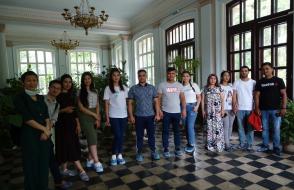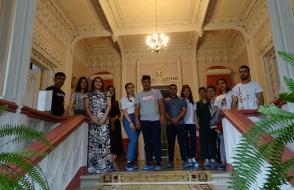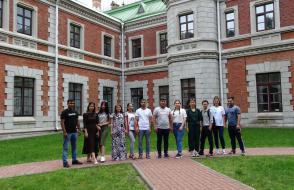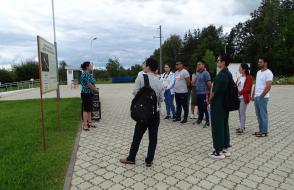This small village in the Zhlobin region has a rich history. One of the most beautiful palace and park complexes in Belarus is located in Krasny Bereg, perfectly preserved to this day. The manor house was built in the eclectic style in 1890-1893. In the palace interiors recreated by restorers, each of the 36 rooms is made in a different style. The staff of the museum, which is now located in the estate, conducted an excursion for the students. Walking through the exquisitely designed halls of the estate, foreign students saw in one place all periods of the development of European architecture. Not a single element of the interior, be it an antique mirror or an armchair, was left without attention. Young people looked at the exhibits with surprise, took selfies. The students were also interested in the manor park, which still contains trees planted by the first owners. According to legend, one of them bestows happiness in personal life if you hug it. Therefore, none of the students missed such a chance to recharge with luck.
The guide revealed completely different events of the past of our country through the history of one estate. The most tragic page in the history of the estate and the agro-town itself was the period of the Second World War. During the occupation, one of the largest transit points in the Gomel region and a children's donor concentration camp were created in Krasny Bereg. The children, who were kept here, were then sent to give blood for the wounded Germans.
The building of the manor itself was not destroyed during the war, it was used as a hospital, so the palace and its interior are quite well preserved. A tour of the memorial complex, created in 2007 in memory of those events, was held for the students. The complex symbolically conveys the horror of those years. In the center of the site, there is a sculpture of a lonely, thin girl who raised her hands up, which is a symbol of all the children who died in the camp. Behind her, a school classroom with empty desks is recreated, on the blackboard there is a letter from a 15-year-old prisoner instead of the topic of the lesson. The central place of the complex is the Sun Square, where the Ship of Hope is located with the names of the dead children. Around the ship there are children's drawings, that was drawn after the war, decorated in the form of stained-glass windows.
The story of the Second World War, which affected the home countries of the students, aroused not only interest, but sincere sympathy. The students asked the guide additional questions about how the war affected the fate of Belarus and talked about similar tragic events that took place in their countries. They recalled that they were taught in school history lessons, discussed how places of memory and objects of historical and cultural heritage are preserved in their homeland.
The students left the territory of the memorial sad, but at the same time inspired and ready for new impressions. They asked themselves the question “What else can you see in Belarus?”.

















